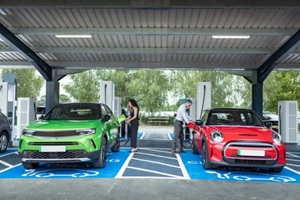


Understanding AC vs. DC Charging for Electric Vehicles
AC vs. DC Charging: What Every EV Driver Should Know
As a leading EV charger manufacturer in China, Topper Company provides reliable electric vehicle charging equipment and comprehensive charging solutions.
As electric vehicles (EVs) become more common, one frequent question from new owners is: What’s the difference between AC and DC charging?
The answer starts with understanding how electricity flows. AC (Alternating Current) is the type of electricity supplied by the power grid — it flows back and forth in a wave-like pattern. DC (Direct Current) flows in a single direction and is how energy is stored in batteries.
Since EV batteries store DC power, any AC electricity from the grid must be converted to DC before charging the battery. The main difference between AC and DC charging lies in where that conversion happens, which affects charging speed and cost.
AC Charging: Convenient for Daily Use
AC charging is the most common method, especially for home and workplace charging. It uses the car’s onboard charger to convert AC into DC power before storing it in the battery.
Affordable Installation: Level 1 chargers plug into a regular outlet, while Level 2 wall boxes offer faster charging and are still reasonably priced.
Perfect for Overnight Charging: Charging at home while you sleep means your EV is ready each morning.
Widespread Availability: AC chargers are found at homes, offices, and public parking areas.
Level 1 (120V): Adds 3–5 miles of range per hour.
Level 2 (208–240V): Adds 12–40 miles per hour, depending on the vehicle’s onboard charger.
⚠ Note: AC charging speed is limited by your EV’s onboard charger. Even if you plug into a 22 kW AC charger, if your car only supports 7 kW, it will charge at 7 kW.
DC Fast Charging: Speed When You Need It
DC fast charging is designed for quick energy boosts, especially during travel. These chargers convert AC to DC inside the station itself, sending DC power directly to the battery and bypassing the car’s onboard charger.
Much Faster: Adds 100+ miles of range in about 20–30 minutes.
Ideal for Long Trips: Installed along highways and major travel routes.
Supports Fleets: Essential for commercial EVs and public transport.
Higher Cost: DC fast chargers are expensive to install due to their power requirements.
Battery Health: Frequent high-speed charging may degrade battery life slightly over time.
Less Common: Mostly found at rest stops, service stations, and EV hubs.
How They Work: Side by Side
| Step | AC Charging | DC Charging |
|---|---|---|
| Conversion | Inside the vehicle | Inside the charger |
| Speed | Slower | Faster |
| Best For | Home & daily use | Long-distance & quick top-ups |
Which One Should You Use?
Most EV drivers use both types depending on their needs. Use AC for daily charging and cost efficiency. Use DC when you’re on the road or need to recharge quickly.
Looking Ahead
EV charging is evolving. Onboard chargers are becoming faster. DC stations now offer up to 350 kW. Smart charging and bidirectional systems (like vehicle-to-grid) are also emerging — helping balance energy use and integrate renewable power.
Conclusion
Understanding AC and DC charging helps you choose the best solution for your routine. AC is your everyday workhorse; DC is your high-speed backup. Together, they keep your EV charged, wherever the road takes you.Learn more about Google SEO.
